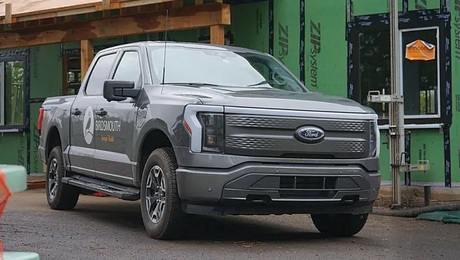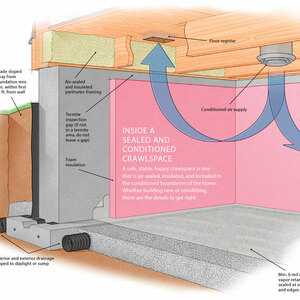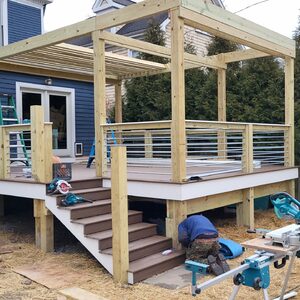I’m in the process of remodeling my house and have the opportunity to install/change the style of my forced air heating/cooling registers.
<!—-><!—-> <!—->
Floors will be hardwood and baseboards will be 5” high.
<!—-> <!—->
What are the pros/cons of the diffident types, floor, baseboard and wall?
<!—-> <!—->
Which do you prefer?
<!—-> <!—->
Are any of the types more efficient?
<!—-> <!—->
How far from the wall/baseboard are floor register typically installed?
<!—-> <!—->
Thanks


















Replies
<What are the pros/cons of the diffident types, floor, baseboard and wall?>
Floor registers pick up all sorts of ****. Use them only when you cannot get to the wall.
I installed floor registers, using flush-mount wood. Other people might like the older look of cast iron (Reggio Registers). In all cases, I think that the register should be flush with the floor. It looks better in my opinion. Install an adjustable vent in the output registers, it will help balance the room.
<How far from the wall/baseboard are floor register typically installed?>
As close as possible.
Thanks for the reply, I have to agree about the floor registers collecting ****.
The original registers, the boots were in the studs of outside wall, took those out to insulate and to move them to the drywall side of the wall or on to the floor.
Edited 11/20/2009 9:05 pm ET by kwik
As I said, I put floor registers in. They have a reasonably horizontal feed, so from time to time I lift them up and vacuum them. No real problems.Some of the nicest floor registers come from Reggio (http://www.reggioregister.com/). I have bought theirs and am quite satisfied. Note that they sell adjustable louvers that sit BELOW the decorative cover.And, although the registers can be placed atop the opening, with a little work you can have them sit flush with the surface. I think that that makes for a nicer appearance.The comments about the wood are valid. If you are going to use the wood ones, you need to get a larger size than you would otherwise use. I have had no problems with heat or cooling in our house with them, and I personally think that they really add to the effect (some are right in the line of sight, but totally unnoticeable).
I looked at the web site for the registers, nice stuff, my wife likes them to. I keep going back and forth with placement, we still have a little time before I make a final decision.
Did look at the height of the baseboard difussers and found out they might not fit against the my baseboards to neatly because of the top trim, baseboard not as tall as I stated.
Thanks
I'd advocate a 'plain' register and install a balancing damper instead ... 'course that assumes you have access to the ducts. You have better control and don't screw up the air flow. Wood and e.g. cast metal often don't have 'directional' louvers on them that help direct air flow, do they? They tend to be more for looks than really 'flowing' air. But I like their looks. Never seen a wood one w/ tapered grids to help keep air flow smooth or otherwise direct it ... more like holes just punched in a 1/2" block of wood.
Hi ClewlessBalancing dampers I have--and always forget to adjust for the season. Heat requires a noticeably different setting, so an adjustable vent seems the best choice at least for me. With the wood ones, or even the decorative metal floor vents, you have to put the adjuster below the register. I have not seen any that include the adjuster as part of the register itself.Look closely at the reggio wood registers. The wood slats are tilted to either side, so as to move the air away from the vent. You are right that the cheaper ones do not have that choice--especially those that you buy at the big box that just sit atop the vent hole.
My system already has dampers, and I do adjust them summer and winter.
Not sure why you would adjust them summer and winter. Once balanced you shouldn't have to change them. Summer air flow should be a lot higher than heating air flow. The balance dampers are normally simply to ensure that you have the right RATIO of air flow between the registers.
I adjust them because our house is no were near finished insulated and we have a wood stove in the main living area. (ranch home)
My wife and I like to have our bedroom on the chilly side in the winter and when we do run the air in the summer we need the extra cooling since this is one room were we have not finished insulating.
One of the reasons I'm asking the questions is to help understand if floor or baseboard registers work differently or if one is preferred over the other.
I'm in the process of slowly replacing the complete heating/cooling system and this is just some of that research, also started looking into the manual J calculations now since we've replace all the windows and have a plan for how we are going to insulate the walls as the remodeling proceeds.
I figured you had 'other factors' causing seasonal air flow adjustments. I agree about the cold bedroom in winter. Can't stand it too hot in the summer, either.
Wall vs. floor. The opinions abound. No particular reason one over the other. Going up into the wall means another elbow and more friction. In residential applications, I've not seen wall registers too much (in fact, consciously can't recall one, but I've likely seen at least a few). Mostly ceiling and/or floor. Like the one guy says, floor ducts collect dust bunnies and junk ... but they are easily maintained a few times a year. Most people would say that wall registers are much more difficult to install/achieve w/ often questionable benefits (relatively speaking).
Thanks for your help and opinions!
It will be up to us to make the final decisions.
Register placement will support either the heating or cooling best, but not both. Since your climate is heating-dominant, i.e., more months of heating than cooling, you will probably do best by placing the registers on the floor. (High sidewall registers would do a better job of cooling.) If you'll have drapes, then place the floor registers out in front of the drapes.
Manufacturers of registers have catalogs that specify things like CFM, air velocity, angle of throw, distance of throw, etc. Each of these factors can have a dramatic effect on how well the register performs, but what you're aiming for is having the register throw the air to mix room air thoroughly without creating drafts in the occupied zone of the room, and without being noisy.
Since you will probably use the same registers to cool the house, it's even more important to ensure good throw from the registers so that the cool air doesn't just crawl across the floor without mixing and cooling air in the occupied zone of the room--that is, the zone up to about 6' above the floor.
One bit of advice, since you are planning on doing hardwood floors, is: DO NOT use a custom made hardwood register that looks pretty, but will reduce airflow so much as to be nearly useless.
Thanks for the heads up on checking the manufactures for the register's info.
I agree with you that the wood floor grilles just block the flow, so far it looks like the diffuser type of baseboard register maybe the way I go for heating and cooling.
Around here they're virtually all floor registers, since the registers should be near the outside walls and the outside walls are filled with insulation. Mostly you see the 2-1/4"x12" ones, or thereabouts.
Usually the registers are placed under windows, and they need to be spaced out enough from the wall to not blow behind any curtains. But if not under windows, the old-fashioned triangular cross-section baseboard registers might look nice with your baseboards.